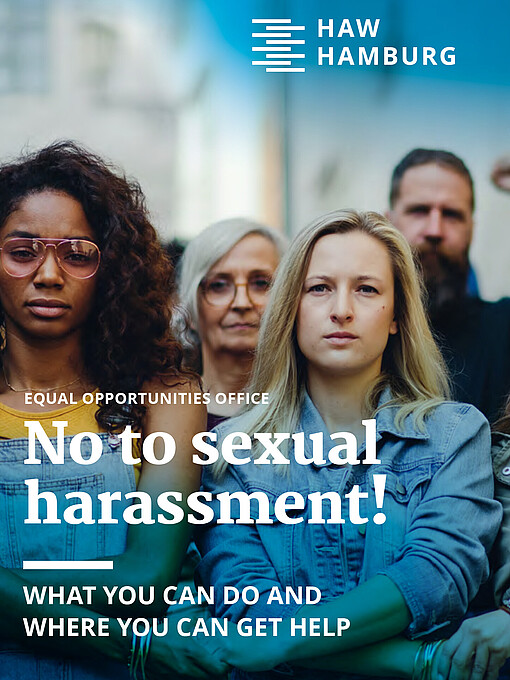Getting help in cases of sexual harassment, discrimination or violence
All members of the university – including employees, students, instructors, contractors, interns, and cleaning staff from external companies – are entitled to protection from sexual harassment, discrimination and violence at HAW Hamburg.
On this page you can find information about what you can do if you experience harassment or observe abusive, harassing behaviour. You will also find a list of support services where you can get assistance, as well as basic legal information and helpful prevention strategies.
Support services in cases of sexual harassment, discrimination or violence

In an emergency you can call the violence against women support hotline around the clock, 365 days of the year.
The LGBTI+Helpline is available Mon–Fri, 7:00 pm–9:00 pm at 0800 133 133. You can contact the Violence against men helpline Mon–Thurs, 8:00 am–8:00 pm and Fri, 8:00 am–3:00 pm at 0800 1239 900.

External support services and online help
In Hamburg and across Germany you can get psychological and legal help as well as advising on specific topics such as violence against trans people and women, domestic violence and violence against men.

Where you can get support at HAW Hamburg
You can get support from any person or entity you are comfortable contacting. Supervisors have a particular responsibility to take action and intervene. The confidential advisors for cases of sexual harassment and violence and all of the equal opportunities commissioners will support you impartially and anonymously if desired. They are also available to assist you with AGG-related complaints.
Information for those who experience or observe sexual harassment and discrimination

Our 'No to sexual harassment!' brochure and poster provide tips to take with you and distribute.
No to sexual harassment! – Brochure
No to sexual harassment! – Poster
What is sexual harassment, discrimination and violence?
Just flirting?! An assault is more than just physical violence. Comments, physical touch or gestures that are unwanted, one-sided, transgressive or derogatory are not flirting – they are sexual harassment and discrimination.
Characteristics
................................................................................................................................................................................................
In order to determine if an experience is sexual harassment or discrimination, it is helpful to ask yourself the following questions: Is one of my personal boundaries being violated verbally, psychologically or physically? If something feels inappropriate, it is inappropriate. What is decisive in defining discrimination is how you feel about the situation, not how the other person meant their actions. These alarm bells in the event of sexual discrimination help to evaluate it.
Sexual discrimination, harassment and violence are ways of exercising power that are intended to violate the other person's dignity. They are often accompanied by sexist, racist or anti-queer/anti-trans hostility and frequently occur in relationships of dependence (e.g. in the workplace, in relationships). Marginalised groups are impacted particularly often.
If the person acting offensively is not being sensitive to the other person's boundaries, they may unintentionally violate their sexual boundaries. This is nevertheless sexual discrimination and violence, because individual boundaries need to be respected at all times and an individual's freely given consent needs to be obtained before any kind of sexualised action or behaviour takes place.
Concrete examples of sexual harassment, discrimination and violence
................................................................................................................................................................................................
- Suggestive or insulting remarks and jokes and inappropriately intimate questions about other people, their appearance, body or private life
- Sending or displaying of pornographic pictures and videos (including dick pics)
- Unwanted verbal or physical advances (including whistling, staring and supposedly coincidental touch)
- Requests to perform sexual acts (sometimes accompanied by promises of professional advantages or threats of negative professional consequences)
- Threats of violence, persecution and coercion as well as physical assault and rape
All these forms of harassment can also be carried out 'digitally' via chats, texts, emails or calls!
What the terms mean
................................................................................................................................................................................................
'Sexualised' makes clear that the perpetrators carry out acts with a sexual connotation primarily to exert or establish power or control. For this reason, sexualised discrimination, harassment and violence do not have anything to do with sexuality. Legal texts continue to use the term 'sexual' harassment.
The umbrella term 'sexualised discrimination and violence' refers to all behaviour with a sexual element that the person targeted experiences as degrading or hurtful and which is intended to make them feel this way. The term 'discrimination' highlights how these actions rely on existing relationships of dependency or structural discrimination (such as sexism, racism and classism) and also include derogatory comments and gestures. In common usage, the meaning of 'harassment' is often narrower. We are continuing to use the term 'harassment' as well because it is so established and is understood by many people.
What you can do if you are being harassed.
What is important in all situations where a boundary is being violated: If you feel that your boundaries are being violated or that the behaviour of the other person isn't or wasn't okay, your experience of the situation is correct. Trust your feelings. They are justified and you don't need to explain yourself!
In the situation
................................................................................................................................................................................................
It is completely normal to be speechless and overwhelmed if you experience discrimination and harassment. If you can, make clear to the person harassing you that you do not agree with their statements and actions and that they have violated your boundaries. Seek support from those nearby. These sentences can help:
SAY 'STOP'.
'I won't put up with this! Stop! This is unacceptable!'
RAISE YOUR VOICE.
Verbalise what just happened. This will make other people realise what is going on. Then they can help you.
'My private life is none of your business!'
'This saying is derogatory!'
'You are way too close to me! Please move further away!'
ASK FOR HELP.
If you don't want to deal with the situation alone, ask people who are nearby for help.
'This person is harassing me. Can you help me?'
LEAVE THE SITUATION.
If you feel physically threatened, get out of the situation as quickly as possible. You can contact the national violence against women support hotline around the clock at 08000 116 016. The LGBTI+Helpline is available Mon–Fri, 7:00 pm–9:00 pm at 0800 133 133. You can contact the Violence against men helpline Mon–Thurs, 8:00 am–8:00 pm and Fri, 8:00 am–3:00 pm at 0800 1239 900.
Following the incident
................................................................................................................................................................................................
- It is worth writing everything down, and backing up emails, chat histories and photos in a secure place where applicable. If others observed the incident, ask them for their names and contact information. These notes will be helpful later in a counselling session and could serve as evidence if you make a complaint or press charges.
- Confide in people close to you. By talking about the experience you can get support and experience feelings of relief.
- Contact the HAW Hamburg confidential advisors for cases of sexual harassment and violence or an external support service. They will work with you to determine what you need now to deal with the situation. They will outline the options available (at HAW Hamburg) to protect you and others from further harassment and to discipline the harasser, and they can implement appropriate interventions. All those providing these services do so in the strictest confidence and can also advise you anonymously. You will not face any disadvantages as a result, and action will only be undertaken if this is what you request.
- Even if you don't want any counselling or help with the concrete situation, please report the incident (this can also be done anonymously) to HAW Hamburg's confidential advisors for cases of sexual harassment and violence. This will ensure that harassment incidents are documented and the responsible offices can develop preventative strategies.
These are your rights.
Sexualised discrimination, harassment and violence are defined and prohibited under labour and criminal law. You have various legal options for obtaining protection and having disciplinary measures enforced.
In work and study contexts
................................................................................................................................................................................................
In work and study contexts, the General Act on Equal Treatment (AGG) and the Hamburg Higher Education Act (HmbHG) assign responsibility to HAW Hamburg for protecting its employees and students from sexualised harassment, discrimination and violence. The HAW Hamburg Anti-Discrimination Policy specifies the contact people and processes for doing so. HAW Hamburg members impacted by such behaviours have the following rights:
- Counselling and support: The right to receive confidential counselling and support from the university's support services if you experience, observe or are directed to carry out discrimination or violence – for example, from the confidential advisors for cases of sexual harassment and violence. They can request that the responsible individuals implement immediate protective measures and interventions.
- Complaints: The right to submit a complaint to the AGG Complaints Office to demand protection and disciplinary measures. Before doing so, you can obtain advice from the confidential advisors for cases of sexual harassment and violence.
- Right to refuse performance: The right to refuse performance without loss of pay when the employer takes no measures or obviously unsuitable measures to stop the harassment or sexual harassment in the workplace (section 14, AGG). However, this only applies when protection cannot be achieved through a milder, less drastic response. Be sure to obtain legal advice prior to taking this step.
- Compensation and damages: The right to receive compensation for material and immaterial damages in those cases where the university does not fulfil its duty of care as an employer (section 15, AGG). Claims must be made within a period of two months.
The Anti-Discrimination Policy also applies when the violence is carried out by or against third parties – e.g. cleaning and security personnel, event attendees, Studierendenwerk Hamburg staff, and other cooperation partners – if at least one of the people involved in the incident is a member or associate member of HAW Hamburg.
Under the Criminal Code
................................................................................................................................................................................................
The German Criminal Code (StGB) regulates 'Crimes against sexual self-determination' and other transgressive actions for which you can press criminal charges.
- Since 2016, physical sexual harassment has been penalised under a specific section of the law (section 184i, StGB).
- However, sexual harassment can also consist of insults, defamation or malicious gossip (sections 185, 186, 187, StGB); (cyber-)stalking (section 238, StGB); coercion (section 240, StGB); threats (section 241, StGB); violation of intimate privacy and of rights of personality by taking photographs or other images (section 201a, StGB); or the unauthorised dissemination of pornographic texts (section 184, StGB).
- Section 177 of the Criminal Code, which covers rape, clearly stipulates that those acts where a person had no opportunity to refuse the sexual act are also punishable by law.
- If you would like to press charges, it is a good idea to obtain legal advice prior to doing so. The confidental advisors for cases of sexual harassment and violence can provide you with contact information.
The Stand Up – Against street harassment campaign provides the opportunity to practice helpful reactions to harassment situations online – as the person being harassed and as a witness.
How you can help those impacted.
If you observe harassment, do something. Speak from your own perspective and ask the person being harassed if they want support in order to avoid being patronising.
What you can do if you observe harassment and discrimination.
................................................................................................................................................................................................
In the situation:
- ASK QUESTIONS.
Ask the person being harassed how they experienced the situation and how you can help.
'I just saw that the person in front of me grabbed your bum. I personally find this behaviour inappropriate. Can I support you somehow?“
- TAKE A STAND.
Get involved in the situation. It often helps when another person steps in and makes clear that they can see the harassment or discrimination taking place. Express your own take on the situation instead of speaking for the person impacted. Be aware of your own safety.
- You can find additional suggestions for what you can say to intervene in our No to sexual harassment! brochure.
In such situations, individuals with leadership, supervisory and educational duties bear a particular responsibility to take action (Anti-Discrimination Policy, preamble).
Following the incident
- Encourage the person to get support and help them get in touch with friends or a support service where necessary, then wait with them until assistance has arrived.
- Offer to accompany them to a support service and to be available as a witness in the event of a complaint or pressing charges, and give them your contact information.
- If you are the supervisor of the person impacted, offer to discuss the situation afterwards in order to determine whether additional protective measures are required, appropriate and desired. The Anti-Discrimination Policy provides guidance in this regard.
- Do not take any further steps without the agreement of the person impacted and maintain confidentiality. It is completely okay if they do not want to take any additional action.
- If you yourself need support (even in your role as the support person), you can contact the confidential advisors for cases of sexual harassment and violence or an external support service.
What you can do when someone tells you they have experienced sexual harassment and discrimination.
................................................................................................................................................................................................
- Take the person seriously and, above all, listen to them. It is a sign of real trust, and it takes a lot of effort to open up to others.
- Do not minimise their experience and don't make them responsible for the incident.
- Encourage the person impacted to deal with the problem offensively and get assistance from one of the support services available, either at the university or externally.
- Offer to help by contacting these support services or accompanying the person to them.
- If you are the supervisor of the person impacted, offer to discuss the situation afterwards in order to determine whether additional protective measures are required, appropriate and desired. The Anti-Discrimination Policy provides guidance in this regard.
- Do not take any steps without speaking to the person impacted and maintain confidentiality.
- If you yourself need support, you can contact the confidential advisors for cases of sexual harassment and violence or an external support service.
How you can help prevent sexual harassment and discrimination.
The most important preventative measure to limit sexualised discrimination in the workplace and in learning environments is a respectful, discrimination-conscious and non-sexualised climate. On the organisational level, it is above all the dismantling of gender-specific power differences that contributes to prevention.
'All members and associate members of HAW Hamburg are called upon to enable and promote discrimination-free cooperation. People with leadership, supervisory and eduational duties bear a particular responsibility here given their position within the hierarchical structures and the resulting relationships of dependence. They actively counter discriminatory behaviours in their area of responsibility, and this policy serves as an important aid in doing so.' (Anti-Discrimination Policy, Preamble)
What each person can do.
................................................................................................................................................................................................
- Be open to self-reflection: If you are unsure whether you yourself have violated someone's boundaries or acted in a discriminatory way, think about your own behaviour in the situation. Sexual harassment can also take place unintentionally because a comment or something meant as a compliment has an unintentionally hurtful effect. In this case what is important is to nevertheless recognise the injury to the person impacted. Depending on the concrete situation, it can be worth talking to the person directly in order to apologise or check in. If you do so, ensure that the situation isn't uncomfortable for them and that the previous situation is not repeated.
- Take every instance of discrimination and harassment seriously: Minimising comments such as 'They're just not able to recognise boundaries, you need to watch out...' reverse the responsibility for harassing behaviour and imply (shared) fault. It becomes even harder for those impacted to make an official complaint or press charges.
- Intervene even after 'harmless' sayings or statements: Even statements that are meant to be funny but are derogatory have an impact on how respected employees in a team feel and how respectfully other employees behave.
- Take professional development courses on anti-discrimination, gender and diversity regularly: Applications for training on these topics are supported by supervisors, the Personnel Department and the Staff Council. The counselling and support services and those employees with leadership, supervisory or educational duties have a particular responsibility to regularly undertake professional development activities. (Anti-Discrimination Policy, section 3.3)
What supervisory and teaching staff can do.
................................................................................................................................................................................................
- Help make talking about the subject less taboo: Talk about the issue and the reality at the university in a team meeting or at the beginning of the semester and provide information about the university's support services. Display flyers in your corridor and at your events.
- Signal your willingness to talk about the issue: Communicate that people can talk to you in cases of sexual harassment, and support those impacted.
- Take a position: Make clear that you will not tolerate transgressive, hurtful or minimising behaviour and that you reject the relativisation of sexualised violence and harassment. Encourage your staff/students to take a clear stance when they see something.
- Implement protective and disciplinary measures: Sexualised harassment and discrimination take place most frequently in organisations where transgressive behaviour does not have any consequences for the perpetrator. In cases of discrimination, harassment or violence, the individual with supervisory responsibilities should take protective and disciplinary measures that are appropriate to and necessary in the individual case (Anti-Discrimination Policy, section 6). Where necessary, you can obtain support from the confidential advisors for cases of sexual harassment and discrimination.
- Promote a respectful and diversity-conscious work environment: Sexualised harassment and discrimination are a reflection and consequence of societal power differences and are thus closely linked to sexism, homophobia, transphobia, racism and classism. Commit to ensuring a discrimination-free environment and prevent the abuse of power and conflicts resulting from competition.
- Encourage your staff to undertake regular training on anti-discrimination, gender and diversity.

